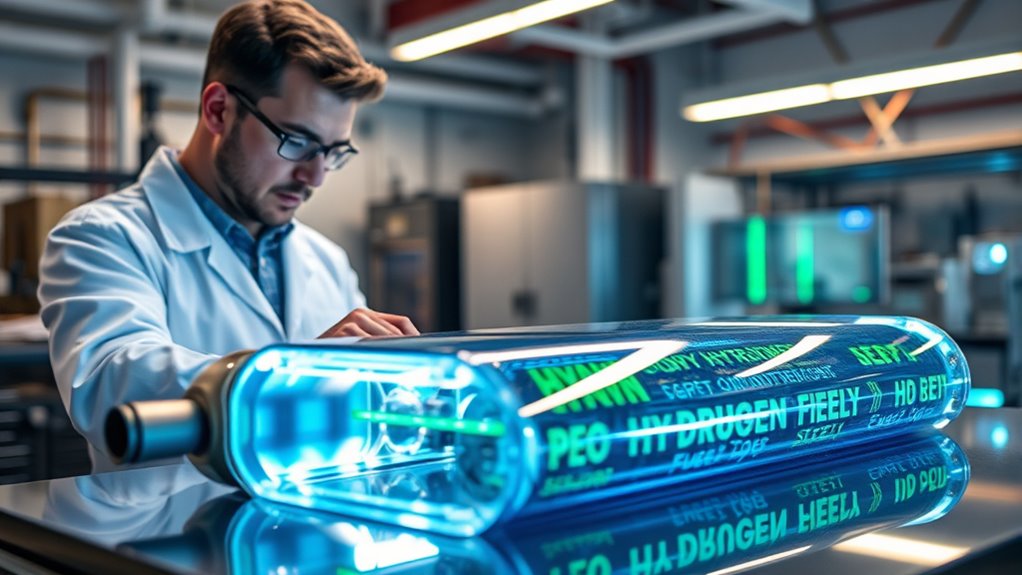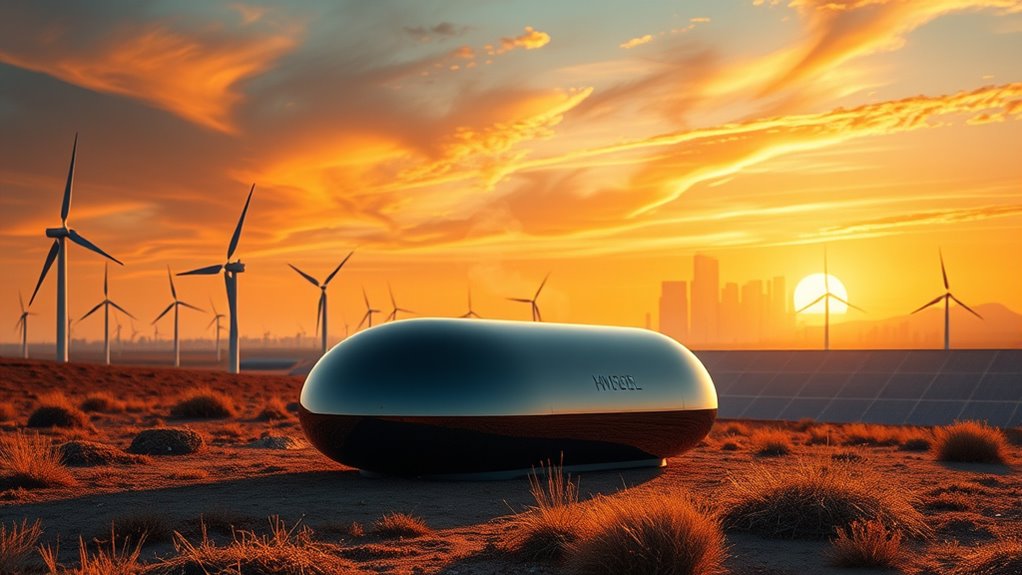Hydrogen fuel cells are paving the way for clean energy by providing efficient, emission-free power without harmful byproducts. They convert hydrogen and oxygen into electricity, emitting only water and heat. Recent innovations in technology are enhancing their performance and reducing costs. However, challenges like high production costs and lack of infrastructure remain. Despite these hurdles, hydrogen could play a key role in a sustainable energy future. Discover how these technologies could reshape our energy landscape.
Key Takeaways
- Hydrogen fuel cells produce electricity with zero harmful emissions, offering a sustainable alternative to traditional fossil fuels.
- Recent technological advancements have significantly improved fuel cell performance and reduced production costs, enhancing their viability in the energy market.
- Hydrogen’s versatility allows applications in transportation, residential heating, and industrial processes, making it a crucial component of future energy systems.
- As renewable energy sources expand, hydrogen fuel cells can provide stable power, reducing greenhouse gas emissions and improving air quality.
- Investment opportunities in hydrogen technologies are growing, driven by increasing demand for clean energy and the potential for job creation in this sector.
The Basics of Hydrogen Fuel Cells

Hydrogen fuel cells are innovative devices that convert chemical energy from hydrogen into electrical power through an electrochemical process. Each fuel cell consists of an anode, cathode, and an electrolyte membrane.
When hydrogen and oxygen combine, they generate electricity, heat, and water. At the anode, hydrogen splits into electrons and protons, while electrons flow through a circuit, producing electricity. Protons move through the electrolyte membrane to the cathode, where they combine with electrons and oxygen to form water. This efficient process makes fuel cells more effective than traditional combustion methods. Additionally, fuel cells are clean and efficient, making them a promising alternative for reducing carbon emissions. Hydrogen fuel cells are also being explored for use in cold weather, highlighting their reliability in various conditions. Moreover, hydrogen can be produced from renewable energy sources, showcasing its potential to support a sustainable energy future. Furthermore, commercial grade heat pumps are increasingly integrated with hydrogen technology, enhancing energy efficiency in large-scale applications. You’ll find hydrogen fuel cells used in various applications, including transportation and stationary power, showcasing their versatility and potential for future energy solutions.
Environmental Advantages of Hydrogen Energy

As awareness of climate change grows, the environmental advantages of hydrogen energy become increasingly relevant.
Hydrogen fuel cells produce only water vapor and heat, which means zero harmful emissions that contribute to climate change. By using hydrogen, you can improve air quality since it reduces harmful particulates and NOx emissions compared to traditional combustion engines. Hydrogen also helps lower carbon footprints in industries like steel and chemicals by replacing carbon-intensive processes. Additionally, you can produce hydrogen using renewable energy sources, creating a sustainable energy loop. This flexibility to the power grid acts as storage for excess renewable energy, providing power during low generation periods. Furthermore, hydrogen energy can be integrated with renewable energy technologies, which are forecasted to increase efficiency by over 40%. Moreover, the combination of hydrogen and AI analytics can lead to optimized energy consumption and distribution strategies. AI enhances threat detection to ensure the security of hydrogen infrastructure against potential cyber threats. Overall, hydrogen energy offers a cleaner, more sustainable future for both the environment and energy security.
Technological Innovations in Fuel Cell Development

Recent breakthroughs in fuel cell technology are transforming how we harness hydrogen energy, making it more efficient and accessible than ever. Innovations in catalyst materials, like platinum-group-metal-free options, have boosted performance by 60%. These new catalysts are cost-effective and enhance energy efficiency, while graphene-based variants show improved durability. In membrane technology, advancements in proton exchange membranes (PEMs) have increased ion conductivity and minimized fuel crossover, further enhancing performance. Additionally, optimized cell geometries and smart control systems improve overall efficiency. With manufacturing innovations driving down costs and supporting high-volume production, fuel cells are becoming more competitive, paving the way for broader adoption in various applications. Enhanced catalyst materials can significantly improve energy conversion efficiencies, ultimately leading to a more sustainable energy future. Embracing these innovations can greatly advance clean energy solutions. Moreover, the growing demand for renewable energy technologies emphasizes the need for efficient hydrogen solutions in the transition towards sustainable practices. As the industry looks towards the future, AI-driven solutions are expected to play a crucial role in optimizing fuel cell performance and production processes. Healthy ecosystems are vital for the longevity of sustainable energy systems, as they provide crucial resources and services that support clean energy technologies.
Challenges Facing Hydrogen Adoption

While technological innovations in fuel cells have made hydrogen more viable as a clean energy source, several challenges still hinder its widespread adoption.
The high cost of producing green hydrogen and reliance on fossil fuels for extraction undermine its sustainability claims. You’ll also find that hydrogen’s low energy density necessitates larger storage solutions, complicating logistics. Hydrogen has a low energy density, complicating storage solutions that require larger fuel tanks than gasoline vehicles. Establishing clear boundaries during the transition to hydrogen energy is crucial for navigating these challenges effectively. Additionally, efficient systems such as heat pumps can provide alternative energy solutions that complement hydrogen technologies. Self-directed IRAs can also play a role in funding innovative energy projects.
High production costs and reliance on fossil fuels challenge hydrogen’s sustainability, while low energy density complicates storage logistics.
The lack of infrastructure, such as refueling stations, makes it hard to integrate hydrogen into the existing energy landscape. Safety concerns, given hydrogen’s high flammability, also affect public perception.
Furthermore, economic barriers like high upfront costs and regulatory inconsistencies further stall progress. To overcome these challenges, significant investments and a commitment to developing reliable supply chains are essential.
Future Outlook for Hydrogen Fuel Cells in Energy Transition

With the ongoing push for cleaner energy solutions, hydrogen fuel cells are set to play a pivotal role in the energy shift. Their versatility across transportation, residential, and industrial sectors makes them a robust choice. By complementing renewable energy sources, hydrogen provides stable power when it’s most needed. As technology advances, efficiency and cost-effectiveness improve, making fuel cells more accessible. The zero-emission nature of hydrogen helps considerably reduce greenhouse gases, contributing to better air quality. Furthermore, the potential for job creation and market growth in hydrogen technology presents exciting investment opportunities. Additionally, zero-emission energy production from hydrogen fuel cells aligns perfectly with global sustainability goals. Notably, the integration of renewable energy sources like solar and wind can enhance the efficiency of hydrogen production through electrolysis. Moreover, the application of predictive modeling can optimize hydrogen production strategies, ensuring resources are allocated effectively. As you consider the future, it’s clear that hydrogen fuel cells will be essential in achieving a sustainable energy landscape. Moreover, the risk management strategies used in cryptocurrency investments can also be applied to managing investments in hydrogen technologies, ensuring a balanced approach to emerging markets.
Frequently Asked Questions
How Does Hydrogen Fuel Compare to Battery Electric Vehicles?
When you compare hydrogen fuel to battery electric vehicles, you’ll notice key differences.
Hydrogen cars offer a longer driving range and quick refueling times, making them convenient for long trips. However, battery electric vehicles are generally more efficient and have a more developed charging infrastructure.
While both produce zero emissions, the environmental impact differs, with electric vehicles being more sustainable overall.
Ultimately, your choice may depend on your driving needs and available infrastructure.
What Are the Safety Measures for Hydrogen Storage?
When it comes to hydrogen storage, you might think it’s a risky endeavor. However, implementing robust safety measures can greatly mitigate those risks.
You need to guarantee outdoor storage for better ventilation, maintain safe distances from structures, and protect areas from extreme weather.
Regular leak detection and fire suppression systems are essential, along with proper handling and transportation protocols.
Compliance with safety codes and thorough employee training will keep everyone safe while working with hydrogen.
Can Hydrogen Fuel Cells Be Used in Homes?
Yes, you can use hydrogen fuel cells in your home. They convert hydrogen and oxygen into electricity, providing efficient, reliable power with minimal environmental impact.
You’ll enjoy benefits like reduced energy bills and increased energy independence, especially when integrated with solar systems.
Plus, they offer backup power during outages, ensuring your home stays powered.
With compact designs, hydrogen fuel cells can fit comfortably in your space, making them a practical energy solution.
How Is Hydrogen Produced From Renewable Sources?
Did you know that producing hydrogen through electrolysis can be up to 70% more energy-efficient than traditional methods?
You can create hydrogen from renewable sources using various techniques. Electrolysis splits water into hydrogen and oxygen with renewable energy.
Biomass gasification transforms organic materials into hydrogen, while thermochemical water splitting uses heat from solar or nuclear sources.
Each method contributes to a cleaner future by reducing greenhouse gas emissions and enhancing energy storage options.
What Are the Leading Countries in Hydrogen Fuel Cell Technology?
If you’re curious about leading countries in hydrogen fuel cell technology, Japan, Germany, and South Korea stand out.
Japan excels in hydrogen vehicle development, while Germany invests heavily in green infrastructure.
South Korea aims to lead in technology by 2040.
The United States focuses on clean hydrogen with substantial government support, and China boasts the third-largest fleet of fuel cell electric vehicles.
These nations are shaping the future of hydrogen energy.
Conclusion
To sum up, hydrogen fuel cells hold promising potential for a cleaner, brighter tomorrow. By harnessing this hydrogen harmony, you can help combat climate change and contribute to a sustainable society. While challenges linger, technological triumphs and environmental benefits pave the path forward. Embrace the exciting energy evolution, and together, let’s fuel the future with clean, green hydrogen solutions. The shift toward a sustainable world is within reach, so let’s ignite innovation and inspire change!










